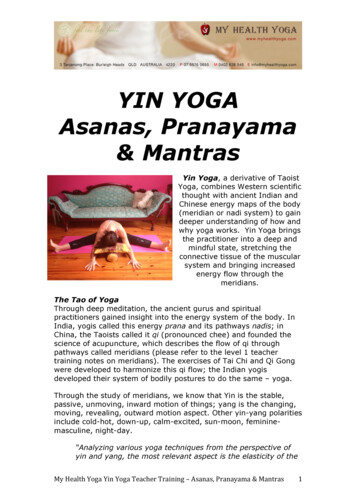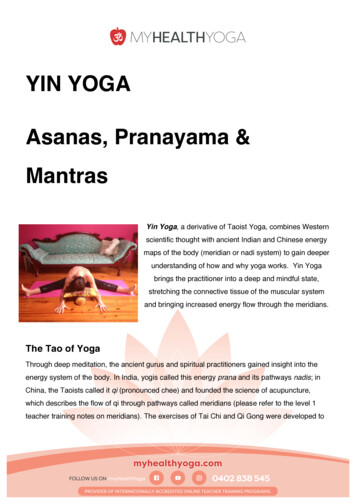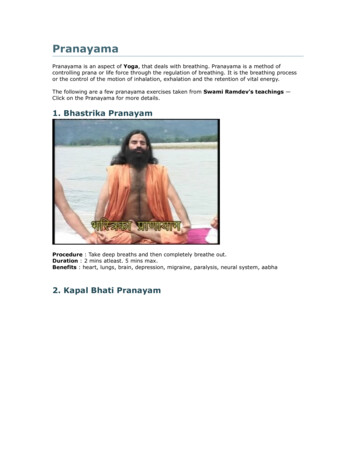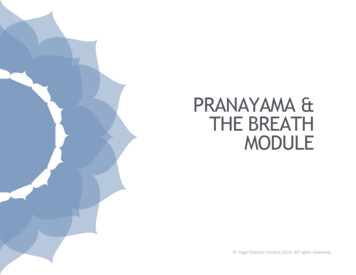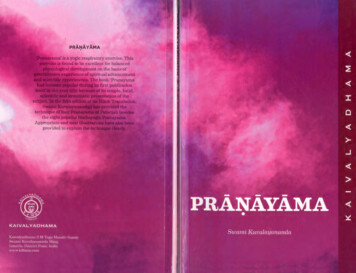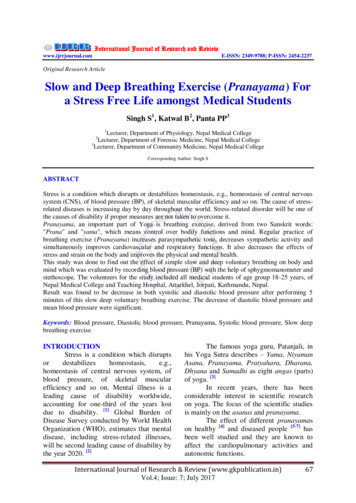
Transcription
THE SCIENCE OF PRANAYAMABySRI SWAMI SIVANANDASri Swami SivanandaFounder ofThe Divine Life SocietySERVE, LOVE, GIVE,PURIFY, MEDITATE,REALIZESo SaysSri Swami SivanandaA DIVINE LIFE SOCIETY PUBLICATION
If you would like to purchasethe print edition, please go ?keywords es139If you would like to contribute tothe dissemination of spiritual knowledge pleasecontact the General Secretary at:generalsecretary@sivanandaonline.orgFirst Edition:1935Sixteenth Edition:1997(6,000 Copies)World Wide Web (WWW) Edition: 2000WWW site: http://www.dlshq.org/This WWW reprint is for free distribution The Divine Life Trust SocietyISBN 81-7052-022-3Published ByTHE DIVINE LIFE SOCIETYP.O. SHIVANANDANAGAR—249 192Distt. Tehri-Garhwal, Uttar Pradesh,Himalayas, India.
PUBLISHERS’ NOTEIt is needless for us to stress on the merits of the subject or its author, Sri Swami SivanandajiMaharaj. Sri Swamiji already lives in the hearts of the people of the world as an ‘unfailing saviour’.The Swamiji’s method of presenting such intricate Yogic subjects in an inimitable, simple stylewith convincing assurances in unique and unrivalled. It is authoritative, the more so, because ofSwamiji being a combination of an experienced medical practitioner, a full-blown Yogi and aJivanmukta.The practice of Pranayama has been viewed with fear in certain quarters on account ofcertain limitations, viz., the absolute necessity of the nearness to a perfected Guru, the dieteticrestrictions and the like. Sri Swamiji has explained herein in clear terms the vagaries of such fearsand has prescribed very simple and safe methods. The book contains suitable lessons for all types ofSadhakas. Those who follow the special instructions given towards the end of the book can be sureof their guaranteed success and safety.Pranayama is an important Anga in Ashtanga Yoga. It is equally necessary for all in theirdaily life, for good health, success and prosperity in every walk of life. How it is so, is explained inthese pages. The science of relaxation is a very valuable gift for the readers and would benefit all.We are greatly encouraged by the warm reception the previous editions had at the hands ofour dear readers and we hope more and more Sadhakas would take up this important aspect ofSadhana in their daily spiritual practices, and feel for themselves the happiness and joy which willnaturally lead them to blissful ‘Divine Life’.—THE DIVINE LIFE SOCIETYINTRODUCTIONToday, for quick travel, the material world presents us the Railway, Steamers, Aeroplanesand so forth, but the Yogins claim that by Yogic culture the weight of the body can be so reducedthat it can fly over the space to any distance in an instant. They can prepare a magic ointment, whichwhen applied to the soles of the feet, gives them power to traverse any distance on earth within avery short time. By the practice of Khechari Mudra, by applying the elongated tongue to theposterior nasal openings they can fly in the air. By keeping a magic pill in their mouth they can alsomove in space to any place in the twinkling of an eye. When we are anxious to know the welfare ofour own relations in a distant or foreign land, we take recourse to writing letters sending ordinary orurgent cables. But the Yogins claim that they can, by meditation (Dyana), know anything thathappens in other parts of the world by a projection of the mind or by mentally travelling the distancewhich is only a matter of few seconds. Yogi Lahiri, whose Samadhi is still in Varanasi, travelled toLondon to see the state of health of his superior’s wife. For hearing a friend at a long distance thematerial world presents us with telephones and wireless receivers, but the Yogins claim thatthrough their Yogic power, they can hear anything, from any distance, even the voices of God andother invisible beings in the firmament. Today when a man is suffering from a disease the materialworld presents us with doctors, medicines, injections and so forth, but the Yogins claim that by aiii
mere glance or by simple touch or by recitation of Mantras, not only the diseases can be cured butalso life can be given to a dead man.These Yogins by persistent effort in concentration get different Yogic powers that areknown as ‘Siddhis’. Those who acquire these Siddhis, are known as Siddhas. The process throughwhich they obtain Siddhis, is called Sadhana. Pranayama is one of the most important Sadhanas.Through the practice of Asana, you can control the physical body and through Pranayama, you cancontrol the subtle, astral body or the Linga Sarira. As there is an intimate connection between thebreath and nerve-currents, control of breath leads to the control of vital inner currents.Pranayama occupies a very important place in Indian religion. Every Brahmachari, andevery Grihastha also, has to practise it three times every day morning, noon and evening in his dailyworship during Sandhya. It precedes every religious practice of the Hindus. Before he eats, beforehe drinks, before he resolves to do anything, Pranayama should be performed first and then thenature of his determination should be clearly enunciated and placed before the mind. The facts of itspreceding every effort of the will is a surety that, that effort will be crowned with success and themind will be directed to bring about the desired result. Here I may refer to the feat of memory,practised by the Hindu Yogins, under the name of concentration on one hundred things.‘Satavadhana’, wherein one hundred questions are put to a Satavadhani or the concentrator in rapidsuccession by different persons; some testing the verbal memory of the performer; others testing hispower of mental calculation; again some others, trying to test his artistic skill, without giving him,any time for committing the questions to have been put to him. The performer begins, byreproducing the questions, in any order, in respect of those questions, with their answers. This isgenerally done in three or more turns, in each turn giving only a portion of the answer to each of thequestions and then continuing from where he left off in the next turn. If the questions are of thenature of mathematical problems whose solutions are required, he delivers the answers along withthe problems, having solved them mentally.This faculty of concentration of mind is often exhibited not only with reference to theintellect but also with reference to the five senses. A number of bells may be marked differently andthe sounds may be allowed to be studied and made mental note of with the mark given to it. Anumber of objects of similar shape and colour which are likely to cause deception to the eye of anordinary man may be shown once to the ‘Avadhani’ with their marks. While he is attending to otherthings, if a bell were to be struck or one of the objects suddenly exhibited before his sight, he will atonce mention the mark of the bell or the number of the object shown. Similarly his keenness oftouch is also put to the test. Such feats of memory are due to the training which they receive from thedaily practice of Pranayama.The Prana may be defined as the finest vital force in everything which becomes visible onthe physical plane as motion and action and on the mental plane as thought. The word Pranayama,therefore, means the restraint of vital energies. It is the control of vital energy which tingles throughthe nerves of persons. It moves his muscles and causes him to sense the external world and think hisinternal thought. This energy is of such a nature that it may be called the vis viva of the animalorganism. The control of this force is what is aimed at by the Yogins by means of Pranayama. Hewho conquers this, is not only the conqueror of his own existence on the physical and mental plane,but the conqueror of the whole world. For, the Prana is the very essence of cosmic life, that subtleiv
principle which evolved the whole universe into its present form and which is pushing it towards itsultimate goal. To the Yogi the whole universe is his body. The matter which composes his body isthe same that evolved the universe. The force which pulsates through his nerves is not differentfrom the force which vibrates through the universe. The conquest over the body does, therefore,mean to him the conquest over the forces of nature. According to the Hindu Philosophy the wholenature is composed of two principal substances. One of them is called the Akasa or ether and theother, Prana or energy. These two may be said to correspond to matter and force of the modernscientists. Everything in this universe that possesses form or that has material existence, is evolvedout of this omnipresent and all-pervasive subtle substance ‘Akasa’. Gas, liquid and solid, the wholeuniverse, consisting of our solar system and millions of huge systems like ours and in fact everykind of existence that may be brought under the word ‘created’, are the products of this one subtleand invisible Akasa and at the end of each cycle return to the starting point. In the same way, all theway of forces of nature that are known to man; gravitation, light, heat, electricity, magnetism allthose that can be grouped under the generic name of ‘energy’, physical creation, nerve-currents, allsuch as are known as animal forces and thought and other intellectual forces also, may be said to bethe manifestations of the cosmic Prana. From Prana, they spring into existence and in Prana, theyfinally subside. Every kind of force in this universe, physical or mental can be resolved into thisoriginal force. There can be nothing new except these two factors in some one of their forms.Conservation of matter and conservation of energy are the two fundamental laws of nature. Whileone teaches that the sum total of Akasa forming the universe, is constant, the other teaches that thesum total of energy that vibrates the universe, is also a constant quantity. At the end of each cyclethe different manifestations of energy quiet down and become potential: so also the Akasa whichbecomes indistinguishable: but at the beginning of the next cycle the energies start up again and acton the Akasa so as to involve the various forms. Accordingly, when the Akasa changes andbecomes gross or subtle, Prana also changes and becomes gross or subtle. As the human body isonly a microcosm to a Yogi, his body composed of the nervous system and the internal organs ofperception represent to him, the microcosmic Akasa, the nerve-currents and thought-currents, andthe cosmic Prana. To understand the secrets of their workings and to control them is, therefore, toget the highest knowledge and the conquest of the universe.He who has grasped this Prana, has grasped the very core of cosmic life and activity. Hewho has conquered and controlled this very essence, has not only subjected his own body and mindbut every other body and mind in this universe. Thus Pranayama or the control of Prana is thatmeans by which the Yogi tries to realise in his little body the whole of cosmic life, and tries to attainperfection by getting all the powers in this universe. His various exercises and trainings are for thisone end.Why delay? Delay means so much of additional suffering and misery. Let us increase thespeed, struggle harder until we succeed in bridging over the vast chasm of time. By doing properSadhana let us attain the goal at once in this body, right now in this very moment. Why not we getthat infinite knowledge, infinite bliss, infinite peace and infinite power, now alone?The solution of the problem is the teaching of Yoga. The whole science ‘Yoga’ has this oneend in view,—to enable man to cross the ocean of Samsara, to increase power, to developknowledge and to attain immortality and eternal bliss.v
CONTENTSPUBLISHERS’ NOTE . . . . . . . . . . . . . . . . . . . . . . . . . . . . . . . . . . . . . . iiiINTRODUCTION . . . . . . . . . . . . . . . . . . . . . . . . . . . . . . . . . . . . . . . . iiiCHAPTER ONEPrana and Pranayama . . . . . . . . . . . . . . . . . . . . . . . . . . . . . . . . . . . . . . . 1What is Prana? . . . . . . . . . . . . . . . . . . . . . . . . . . . . . . . . . . . . . . . . . . . 1Seat of Prana . . . . . . . . . . . . . . . . . . . . . . . . . . . . . . . . . . . . . . . . . . . . 3Sub-Pranas and Their Functions . . . . . . . . . . . . . . . . . . . . . . . . . . . . . . . . . . 3The Colour of Pranas . . . . . . . . . . . . . . . . . . . . . . . . . . . . . . . . . . . . . . . . 3The Length of the Air-Currents . . . . . . . . . . . . . . . . . . . . . . . . . . . . . . . . . . 3The Centering of the Prana . . . . . . . . . . . . . . . . . . . . . . . . . . . . . . . . . . . . . 4The Lungs . . . . . . . . . . . . . . . . . . . . . . . . . . . . . . . . . . . . . . . . . . . . . 4Ida and Pingala . . . . . . . . . . . . . . . . . . . . . . . . . . . . . . . . . . . . . . . . . . . 6Sushumna . . . . . . . . . . . . . . . . . . . . . . . . . . . . . . . . . . . . . . . . . . . . . 7Kundalini. . . . . . . . . . . . . . . . . . . . . . . . . . . . . . . . . . . . . . . . . . . . . . 7Shat-Chakras . . . . . . . . . . . . . . . . . . . . . . . . . . . . . . . . . . . . . . . . . . . . 7Nadis . . . . . . . . . . . . . . . . . . . . . . . . . . . . . . . . . . . . . . . . . . . . . . . . 8Purification of Nadis . . . . . . . . . . . . . . . . . . . . . . . . . . . . . . . . . . . . . . . . 8Shat-Karmas (The Six Purificatory Processes) . . . . . . . . . . . . . . . . . . . . . . . . . . . 9Dhauti. . . . . . . . . . . . . . . . . . . . . . . . . . . . . . . . . . . . . . . . . . . . . . . 10Basti . . . . . . . . . . . . . . . . . . . . . . . . . . . . . . . . . . . . . . . . . . . . . . . 10Neti . . . . . . . . . . . . . . . . . . . . . . . . . . . . . . . . . . . . . . . . . . . . . . . . 11Trataka (Gazing) . . . . . . . . . . . . . . . . . . . . . . . . . . . . . . . . . . . . . . . . . 12Nauli . . . . . . . . . . . . . . . . . . . . . . . . . . . . . . . . . . . . . . . . . . . . . . . 12Kapalabhati . . . . . . . . . . . . . . . . . . . . . . . . . . . . . . . . . . . . . . . . . . . . 12The Meditation Room.The Five Essentials . .The Place . . . . . . .The Time . . . . . . .The Adhikari . . . . .Dietetic Discipline . .Yogic Diet . . . . . .Mitahara . . . . . . .Purity in Food . . . . .Charu . . . . . . . . .Milk Diet . . . . . . .Fruit Diet . . . . . . .Articles Allowed . . .Articles Forbidden . .A Kutir For Sadhana .Matra . . . . . . . . .CHAPTER TWO. . . . . . . . . . . . . . . . . . . . . . . . . . . . . . . . . . . . . . . . . . . . . . . . . . . . . . . . . . . . . . . . . . . . . . . . . . . . . . . . . . . . . . . . . . . . . . . . . . . . . . . . . . . . . . . . . . . . . . . . . . . . . . . . . . . . . . . . . . . . . . . . . . . . . . . . . . . . . . . . .vi.14151515161617171717181818181919
Padmasana (Lotus Pose) . . . .Siddhasana (The Perfect Pose) .Svastikasana (Prosperous Pose)Samasana (Equal Pose) . . . . .Three Bandhas . . . . . . . . .Arambha Avastha. . . . . . . .Ghata Avastha . . . . . . . . .Parichaya Avastha . . . . . . .Nishpatti Avastha . . . . . . . .192021222225252526CHAPTER THREEWhat is Pranayama . . . . . . . . . . . . . . . . . . . . . .Pranayama (According to the Gita) . . . . . . . . . . . . . .Pranayama (According To Sri Sankaracharya) . . . . . . . .Pranayama (According to Yogi Bhusunda) . . . . . . . . . .Control of Breath . . . . . . . . . . . . . . . . . . . . . . .Varieties of Pranayama . . . . . . . . . . . . . . . . . . . .Three Types of Pranayama . . . . . . . . . . . . . . . . . .The Vedantic Kumbhaka . . . . . . . . . . . . . . . . . . .Pranayama for Nadi-Suddhi . . . . . . . . . . . . . . . . .Mantra During Pranayama . . . . . . . . . . . . . . . . . .Exercise No. 1 . . . . . . . . . . . . . . . . . . . . . . . .Exercise No. 2 . . . . . . . . . . . . . . . . . . . . . . . .Exercise No. 3 . . . . . . . . . . . . . . . . . . . . . . . .Exercise No. 4 . . . . . . . . . . . . . . . . . . . . . . . .Deep Breathing Exercise . . . . . . . . . . . . . . . . . . .Kapalabhati . . . . . . . . . . . . . . . . . . . . . . . . . .The External Kumbhaka (Bahya) . . . . . . . . . . . . . . .Easy Comfortable Pranayama (Sukha Purvaka) . . . . . . .Pranayama for Awakening Kundalini. . . . . . . . . . . . .Pranayama During Meditation . . . . . . . . . . . . . . . .Pranayama While Walking . . . . . . . . . . . . . . . . . .Pranayama in Savasana . . . . . . . . . . . . . . . . . . . .Rhythmical Breathing . . . . . . . . . . . . . . . . . . . .Surya Bheda . . . . . . . . . . . . . . . . . . . . . . . . .Ujjayi . . . . . . . . . . . . . . . . . . . . . . . . . . . . .Sitkari. . . . . . . . . . . . . . . . . . . . . . . . . . . . .Sitali . . . . . . . . . . . . . . . . . . . . . . . . . . . . .Bhastrika . . . . . . . . . . . . . . . . . . . . . . . . . . .Bhramari . . . . . . . . . . . . . . . . . . . . . . . . . . .Murchha . . . . . . . . . . . . . . . . . . . . . . . . . . .Plavini . . . . . . . . . . . . . . . . . . . . . . . . . . . .Kevala Kumbhaka . . . . . . . . . . . . . . . . . . . . . .Pranic Healing . . . . . . . . . . . . . . . . . . . . . . . .Distant Healing . . . . . . . . . . . . . . . . . . . . . . . .Relaxation . . . . . . . . . . . . . . . . . . . . . . . . . 041414243434444454646vii.
Relaxation of Mind . . . . . . . . . . . . . . . . . . . . . . . . . . . . . . . . . . . . . . . . 46Importance and Benefits of Pranayama . . . . . . . . . . . . . . . . . . . . . . . . . . . . . . 47Special Instructions . . . . . . . . . . . . . . . . . . . . . . . . . . . . . . . . . . . . . . . . 48Concentration on Solar PlexusPancha Dharana. . . . . . . .Story of Yogi Bhusunda . . .The Inner Factory . . . . . . .Yogic Diet . . . . . . . . . .Sivananda’s Pranayama . . .Kundalini Pranayama . . . . .Questions and Answers . . . .Glossary . . . . . . . . . . .APPENDIX. . . . . . . . . . . . . . . . . . . . . . . . . . . . . . . . . . . . . . . . . . . . . . . . . . . . . . . . . . . . . . . .viii.545556565762626366
Chapter OnePrana and PranayamaPranayama is an exact science. It is the fourth Anga or limb of Ashtanga Yoga. “TasminSati Svasa prasvasayorgativicchedah Pranayamah”—Regulation of breath or the control of Pranais the stoppage of inhalation and exhalation, which follows after securing that steadiness of postureor seat, Asana. Thus is Pranayama defined in Patanjali Yoga Sutras, Chapter II-49.‘Svasa’ means inspiratory breath and ‘Prasvasa’ is expiratory breath. Breath is externalmanifestation of Prana, the vital force. Breath like electricity, is gross Prana. Breath is Sthula, gross.Prana is Sukshma, subtle. By exercising control over this breathing you can control the subtle Pranainside. Control of Prana means control of mind. Mind cannot operate without the help of Prana. Thevibrations of Prana only produce thoughts in the mind. It is Prana that moves the mind. It is Pranathat sets the mind in motion. It is the Sukshma Prana or Psychic Prana that is intimately connectedwith the mind. This breath represents the important fly-wheel of an engine. Just as the other wheelsstop when the driver stops the fly-wheel, so also other organs cease working, when the Yogi stopsthe breath. If you can control the fly-wheel, you can easily control the other wheels. Likewise, ifyou can control the external breath, you can easily control the inner vital force, Prana. The processby which the Prana is controlled by regulation of external breath, is termed Pranayama.Just as a goldsmith removes the impurities of gold by heating it in the hot furnace, bystrongly blowing the blow-pipe, so also the Yogic student removes the impurities of the body andthe Indriyas by blowing his lungs, i.e., by practising Pranayama.The chief aim of Pranayama is to unite the Prana with the Apana and take the unitedPranapana slowly towards the head. The effect or fruit of Pranayama is Udghata or awakening ofthe sleeping Kundalini.What is Prana?“He who knows Prana knows Vedas” is the important declaration of the Srutis. You willfind in Vedanta Sutras: “For the same reason, breath is Brahman.” Prana is the sum total of allenergy that is manifest in the universe. It is the sum total of all the forces in nature. It is the sum totalof all latent forces and powers which are hidden in men and which lie everywhere around us. Heat,light, electricity, magnetism are the manifestations of Prana. All forces, all powers and Prana springfrom the fountain or common source, ‘Atman’. All physical forces, all mental forces come underthe category ‘Prana’. It is force on every plane of being, from the highest to the lowest. Whatevermoves or works or has life, is but an expression or manifestation of Prana. Akasa or ether also is anexpression of Prana. The Prana is related to mind and through mind to will, and through will to theindividual soul, and through this to the Supreme Being. If you know how to control the little wavesof Prana working through the mind, then the secret of subjugating universal Prana will be known toyou. The Yogi who becomes an expert in the knowledge Of this secret, will have no fear from anypower, because he has mastery over all the manifestations of powers in the universe. What iscommonly known as power of personality is nothing more than the natural capacity of a person to1
THE SCIENCE OF PRANAYAMAwield his Prana. Some persons are more successful in life, more influential and fascinating thanothers. It is all due to the power of this Prana. Such people manipulate everyday, unconsciously ofcourse, the same influence which the Yogi uses consciously by the command of his will. There areothers who by chance tumble unaware of this Prana and use it for lower purposes under false names.This working of Prana is seen in the systolic and diastolic actions of the heart, when it pumps theblood into arteries in the action of inspiration and expiration during the course of breathing; in thedigestion of food; in the excretion of urine and faecal matter; in the manufacture of semen, chyle,chyme, gastric juice, bile, intestinal juice, saliva; in closing and opening of the eyelids, in walking,playing, running, talking, thinking, reasoning, feeling and willing. Prana is the link between theastral and physical body. When the slender thread-link Prana is cut off the astral body separatesfrom the physical body. Death takes place. The Prana that was working in the physical body iswithdrawn into the astral body.This Prana remains in a subtle, motionless, unmanifested, undifferentiated state during thecosmic Pralaya. When the vibration is set up, Prana moves and acts upon Akasa, and brings forththe various forms. The macrocosm (Brahmanda) and microcosm (Pindanda) are combinations ofPrana (energy) and Akasa (matter).That which moves the steam-engine of a train and a steamer, that which makes theaeroplanes fly in air, that which causes the motion of the breath in lungs, that which is the very lifeof this breath itself, is Prana. I believe, you have now a comprehensive understanding of the termPrana about which you had a very vague conception in the beginning.By controlling the act of breathing you can efficiently control all the various motions in thebody and the different nerve-currents that are running through the body. You can easily and quicklycontrol and develop body, mind and soul through breath-control or the control of Prana. It isthrough Pranayama that you can control your circumstances and character and can consciouslyharmonise the individual life with the cosmic life.The breath, directed by thought under the control of the will, is a vitalising, regeneratingforce which you can utilise consciously for self-development; for healing many incurable diseasesin your system; for healing others and for other various useful purposes.It is within your easy reach at every moment of your life. Use it judiciously. Many Yogins ofyore, like Sri Jnanadeva, Trailinga Swami, Ramalinga Swami and others, had utilised this breath,this force, the Prana, in a variety of ways. You can also do so, if you practise Pranayama byprescribed breathing exercises. It is Prana that you are breathing rather than the atmospheric air.Inhale slowly and steadily with a concentrated mind. Retain it as long as you can do it comfortably.Then exhale slowly. There should be no strain in any stage of Pranayama. Realise the occult innerlife-powers which underlie the breath. Become a Yogi and radiate joy, light and power all aroundyou. Pranavadins or Hatha Yogins consider that Prana Tattva is superior to Manas Tattva, themind-principle. They say, Prana is present even when the mind is absent during sleep. Hence Pranaplays a more vital part than the mind. If you go through the parables in Kaushitaki and ChhandogyaUpanishads, when all the Indriyas, mind and Prana fight amongst themselves as to their superiority,you will find that Prana is regarded as the highest of all. Prana is the oldest, for it starts itsfunctioning from the very moment the child is conceived. On the contrary, the organs of hearing,2
THE SCIENCE OF PRANAYAMAetc., begin to function only when their special abodes, viz., the ears, etc., are formed. Prana is calledJyeshtha and Sreshtha (oldest and best) in Upanishads. It is through the vibrations of psychic Pranathat the life of the mind, Sankalpa or thinking is kept up and thought is produced. You see, hear,talk, sense, think, feel, will, know, etc., through the help of Prana and therefore Srutis declare:“Prana is Brahman.”Seat of PranaThe seat of Prana is heart. Though the Antahkarana is one, yet it assumes four forms, viz., (i)Manas, (ii) Buddhi, (iii) Chitta and (iv) Ahamkara according to the different functions it performs.Likewise, though Prana is one, it assumes five forms viz., (1) Prana, (2) Apana, (3) Samana, (4)Udana and (5) Vyana according to the different functions it performs. This is termed as VrittiBheda. The principal Prana is called Mukhya Prana. The Prana, joined with Ahamkara, lives in theheart. Of these five, Prana and Apana are the chief agents.The seat of Prana is the heart; of Apana, the anus; of Samana, the region of the naval; ofUdana, the throat; while Vyana is all-pervading. It moves all over the body.Sub-Pranas and Their FunctionsNaga, Kurma, Krikara, Devadatta and Dhananjaya are the five sub-Pranas.The function of Prana is respiration; Apana does excretion; Samana performs digestion;Udana does deglutition (swallowing of the food). It takes the Jiva to sleep. It separates the astralbody from the physical body at the time of death. Vyana performs circulation of blood.Naga does eructation and hiccup. Kurma performs the function of opening the eyes. Krikarainduces hunger and thirst. Devadatta does yawning. Dhananjaya causes decomposition of the bodyafter death. That man is never reborn, whenever he may die, whose breath goes out of the head, afterpiercing the Brahmarandhra.The Colour of PranasPrana is said to be of the colour of blood, red gem or coral. Apana which is in the middle, isof the colour of Indragopa (an insect of white or red colour). Samana is of the colour between that ofpure milk or crystal or of oily and shining colour, i.e., of something between both Prana and Apana.Udana is of Apandura (pale white) colour and that of Vyana, resembles the colour of archil (or thatof ray of light).The Length of the Air-CurrentsThis body of Vayu is 96 digits (6 feet) in length as a standard. The ordinary length of theair-current, when exhaled is 12 digits (9 inches). In singing, its length becomes 16 digits (1 foot), ineating it comes to 20 digits (15 inches), in sleeping 30 digits (22 1/2 inches), in copulation 36 digits(27 inches) and in doing physical exercise it is much more than that. By decreasing the natural3
THE SCIENCE OF PRANAYAMAlength of the expirer air-currents (from 9 inches), life is prolonged and by increasing the current,duration of life is decreased.The Centering of the PranaInhaling the Prana from outside, filling the stomach with it, centre the Prana with the mind,in the middle of the navel, at the tip of the nose, and at the toes, during the ‘Sandhyas’ (sunrise andsunset) or at all times. Thus the Yogi is freed from all diseases and fatigues. By centering this Pranaat the tip of the nose
SRI SWAMI SIVANANDA Sri Swami Sivananda Founder of The Divine Life Society SERVE, LOVE, GIVE, PURIFY, MEDITATE, REALIZE So Says Sri Swami Sivananda A DIVINE LIFE SOCIETY PUBLICATION . If you would like to purchase the print edition, please go to:


